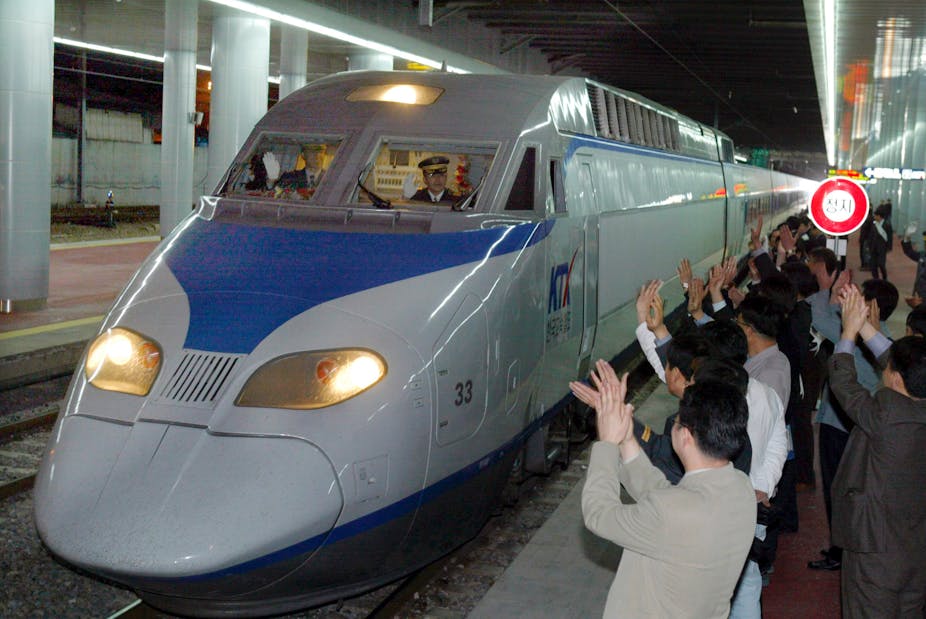The CLARA private consortium claims a high speed rail network between Sydney and Melbourne could be paid for at no cost to the government through a technique known as value capture. What is still not clear is whether there will be enough value created by the project to capture in order to pay for the project.
Value capture is well established techniques used by governments to offset some of the costs of new transport infrastructure, for instance the taxes paid on apartments built near a new train station help to offset the cost of the transport investment. The taxes paid by warehouses or factories built near new freeways are another good example of value capture.
CLARA’s proposal is that the high speed rail can be paid for by purchasing land cheaply in regional New South Wales and Victoria then developing a string of new towns alongside the High Speed Railway. The sale of land would fund the High Speed Railway’s construction and the new residents would provide patronage for the railway.
This form of development was once common place with the suburban railways of London and the urban railways of Tokyo and Hong Kong being the most famous examples. However, this sort of value capture by private investors is much rarer today and unprecedented on this scale.
The first stage proposal involves a A$13 billion link from Melbourne to the Greater Shepparton region of Northern Victoria, the full link to Sydney with a branch to Canberra would cost many times this much. The CLARA consortium is claiming the exact figure as commercial in confidence, but a cost of around $200 billion has been suggested in the media.
CLARA haven’t released the full business case for the network but value of the project can be assessed by its benefits and whether or not the project will capture them.
High speed rail creates benefits for two types of travellers, longer distance commuters and intercity travellers. Previous proposals for high speed rail have floundered in Australia because the benefits to intercity travellers have just not been enough to justify the costs of developing and running it.
Australian cities are just too far apart for a high speed rail to be competitive on travel time and fares with aviation. Perhaps this will change over the 40 years that it will take to build the network but there is no evidence that this is happening at the moment.
Unlike previous plans, CLARA is emphasising the potential of the longer distance commuter market (e.g. Canberra or Goulburn to Sydney). There is a developing market for commuting by High Speed Rail in the UK amongst other countries.
There is no doubt that high speed rail would be faster over these sorts of distances than the alternatives (ordinary rail, coaches, private car) although it might be a challenge to schedule high speed intercity services alongside slower commuter services and building dedicated high speed rail lines into the Central Business Districts of Sydney and Melbourne will be very expensive. These travellers will gain benefits from a faster service and also from being able to purchase houses in more affordable regional areas.
Land prices are a capitalisation of the benefits that accrue to people who use that land. In the case of residential land, it reflects the benefits to be had in terms of access to schools, jobs, recreation facilities, etc.
Improved transport services reduce the time it takes to get to existing jobs and activities plus makes it possible to travel to additional jobs and activities within a reasonable time and, finally, encourages new jobs and activities to be created through the process of economies of scale and agglomeration.
Some of these benefits accrue to the travellers, others to the owners of the businesses who can hire from a bigger pool of potential employees and service a bigger pool of customers. Because of these benefits travellers and businesses bid up the price of land in places near the improved transport services thus sharing the benefits with the land owners (and with governments in the form of the taxes paid on income, property transactions and developments). It is this increase in land that CLARA hopes to tap into to fund the new high speed rail.
This project will only be successful if the new rail service generates enough benefits and this will only happen if people really will be prepared to pay higher fares for high speed rail or prefer lower fares on traditional train services from cities closer in (i.e. Wollongong). If not, will governments have to ban development in other cities to force people to move to CLARA’s townships in order to support the developers of the HSR?
Value capture is a rediscovered form of financing major projects that could prove an innovative source of funds but it does not remove the need for a project’s benefits to exceed its costs.

